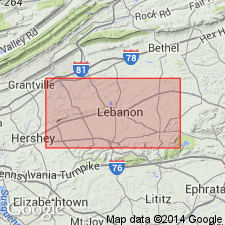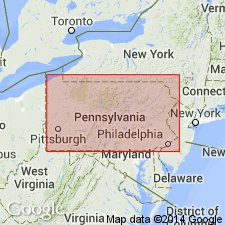
- Usage in publication:
-
- Schaefferstown member
- Modifications:
-
- Named
- Dominant lithology:
-
- Limestone
- AAPG geologic province:
-
- Appalachian basin
Summary:
Named the Schaefferstown member of the Conococheague formation for Schaefferstown, Lebanon Co., southeastern PA. Unit is limestone sequence that stratigraphically overlies the Snitz Creek member; top is drawn at base of first bed of white to pinkish-gray, crystalline limestone of overlying Millbach member. Consists of medium-light- to medium-gray limestone with distinct shaly bands and laminae; rock is thick bedded in fresh exposures; some pinkish-gray limestone beds near base; shaly bands and laminae are carbonaceous and make member particularly susceptible to flowage. Thickness probably 200 to 300 feet; partial type section is 68 feet with neither top nor base exposed. The Schaefferstown is of Late Cambrian age.
Source: GNU records (USGS DDS-6; Reston GNULEX).

- Usage in publication:
-
- Schaefferstown formation
- Modifications:
-
- Revised
- AAPG geologic province:
-
- Appalachian basin
Summary:
Raised the Schaefferstown to the Schaefferstown formation of the Conococheague group in southeastern PA.
Source: GNU records (USGS DDS-6; Reston GNULEX).

- Usage in publication:
-
- Schaefferstown Formation*
- Modifications:
-
- Overview
- AAPG geologic province:
-
- Appalachian basin
Summary:
The Schaefferstown Formation of the Conococheague Group consists of light-gray to gray limestone containing shaly bands and laminae. Patches and thin beds of gray calcarenite are characteristic of the member. Some pinkish-gray limestone occurs near base. Thickness is about 200 to 300 feet. Overlies the Snitz Creek Formation and underlies the Millbach Formation, both of the Conococheague Group.
Source: GNU records (USGS DDS-6; Reston GNULEX).

- Usage in publication:
-
- Schaefferstown Formation
- Modifications:
-
- Overview
- AAPG geologic province:
-
- Appalachian basin
Summary:
The Schaefferstown Formation in the Lebanon Valley sequence of the Great Valley consists of gray, thin-bedded limestone containing siliceous and argillaceous laminae. Overlies the Snitz Creek Formation and underlies the Millbach Formation. On State map, the Schaefferstown is mapped with the Millbach Formation.
Source: GNU records (USGS DDS-6; Reston GNULEX).
For more information, please contact Nancy Stamm, Geologic Names Committee Secretary.
Asterisk (*) indicates published by U.S. Geological Survey authors.
"No current usage" (†) implies that a name has been abandoned or has fallen into disuse. Former usage and, if known, replacement name given in parentheses ( ).
Slash (/) indicates name conflicts with nomenclatural guidelines (CSN, 1933; ACSN, 1961, 1970; NACSN, 1983, 2005, 2021). May be explained within brackets ([ ]).

